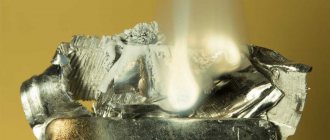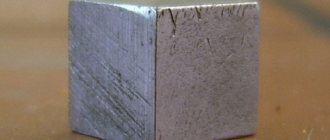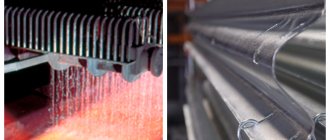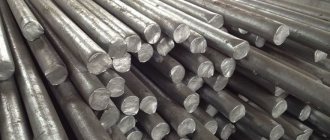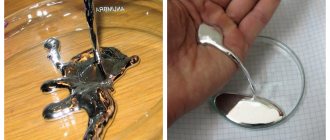Tin is a soft, silvery-white metal. It is so malleable and pliable that its sheets a thousandth of a millimeter thick can be rolled into a tube. This material is called tin paper. In D.I. Mendeleev’s periodic table of elements, this element corresponds to number 50, atomic weight 118.69 and the sign “Sn” (from the Latin stannum). There are 10 known stable isotopes. The metal is obtained mainly from the mineral cassiterite, which is tin dioxide.
The metal alloyed with lead is mainly used for soldering. It is also used as an anti-corrosion coating for food steel containers as it is non-toxic. Composites containing tin are used as fungicides, paints, toothpaste (SnF2) and ceramics.
History of the discovery and study of tin
Based on archaeological finds, scientists were able to establish that humanity became acquainted with tin back in the 4th millennium BC. e. Written reminders of this metal can be found in the Fourth Book of Moses, the Bible.
At first, tin was scarcely available. It could only be found among rulers, generals, wealthy citizens, and merchants. It was the main component of tin bronze, which appeared in the mid-3rd millennium BC. e. At that time, bronze was considered the most durable alloy. The components for its manufacture were of exceptional value during the Bronze Age.
Separated from impurities, the pure metal was obtained in the 12th century. It is mentioned in the works of R. Bacon.
Occurrence of tin in nature
The prevalence of tin in nature is shown in the following table:
| Geol. an object | Kamen. meteorites | Dunits and others. | Basalts, etc. | Diorites, etc. | Granitoids | Glina, etc. | Ocean water | Live matter (% of live weight) | The soil | Plant ash |
| Contents, weight. % | 001⋅10−4 | 05⋅10−5 | 01,5⋅10−4 | 0000− | 0003⋅10−4 | 1⋅10−3 | 07⋅10−7 | 00005⋅10−5 | 1⋅10−3 | 005⋅10−4 |
In unpolluted surface waters, tin is found in submicrogram concentrations. In groundwater its concentration reaches several micrograms per liter, increasing in the area of tin ore deposits, it enters the water due to the destruction primarily of sulfide minerals, which are unstable in the oxidation zone. PDKSn = 2 mg/dm³.
Tin is an amphoteric element, that is, an element capable of exhibiting acidic and basic properties. This property of tin also determines the characteristics of its distribution in nature. Due to this duality, tin exhibits lithophilic, chalcophilic and siderophilic properties. Tin in its properties is close to quartz, as a result of which the close connection of tin in the form of oxide (cassiterite) with acidic granitoids (lithophilicity), often enriched in tin, is known, up to the formation of independent quartz-cassiterite veins. The alkaline behavior of tin is determined by the formation of quite a variety of sulfide compounds (chalcophilicity), up to the formation of native tin and various intermetallic compounds known in ultrabasic rocks (siderophilicity).
Forms of location
The main form of occurrence of tin in rocks and minerals is scattered (or endocript). However, tin also forms mineral forms, and in this form it is often found not only as an accessory in acidic igneous rocks, but also forms industrial concentrations mainly in oxide (cassiterite SnO2) and sulfide (stannine) forms.
Solid phase. Minerals
In general, the following forms of tin occurrence in nature can be distinguished:
- Scattered form
; the specific form of tin in this form is unknown. Here we can talk about an isomorphically dispersed form of tin occurrence due to the presence of isomorphism with a number of elements (Ta, Nb, W - with the formation of typically oxygen compounds; V, Cr, Ti, Mn, Sc - with the formation of oxygen and sulfide compounds). If tin concentrations do not exceed certain critical values, then it can isomorphically replace the named elements. The mechanisms of isomorphism are different. - Mineral Form
: Tin is found in concentrating minerals. As a rule, these are minerals in which iron Fe+2 is present: biotites, garnets, pyroxenes, magnetites, tourmalines, etc. This relationship is due to isomorphism, for example, according to the scheme Sn+4 + Fe+2 → 2Fe+3. In tin-bearing skarns, high concentrations of tin are found in garnets (up to 5.8 wt.%) (especially in andradites), epidotes (up to 2.84 wt.%), etc.
In sulfide deposits, tin is included as an isomorphic element in sphalerites (Silinskoye deposit, Russia, Primorye), chalcopyrites (Dubrovskoye deposit, Russia, Primorye), and pyrites. High concentrations of tin were detected in pyrrhotite from greisen from the Smirnovskoe deposit (Russia, Primorye). It is believed that due to limited isomorphism, solid solutions decompose with micro-precipitates of Cu2+1Fe+2SnS4 or tillite PbSnS2 and other minerals.
Obtaining tin from ore and deposits
The process of obtaining the alloy depends on the form in which it was found. Tin in the form of ore does not differ significantly from the production of other non-ferrous metals. The process consists of three stages:
- Extraction, processing of consumable raw materials (ore).
- Reduction smelting to obtain rough metal.
- Refining prepared raw materials using acceptable methods.
The development of placer deposits is carried out using industrial sand pumps.
Cassiterite article: Cassiterite
Cassiterite
(from the Greek kassiteros - tin) - the main ore mineral for the production of tin. Theoretically contains 78.62% Sn. It forms separate secretions, grains, continuous massive aggregates, in which the grains of the mineral reach a size of 3 - 4 mm and even more.
- Density 6040-7120 kg/m³ (lowest for light-colored cassiterites).
- Hardness 6½.
- The shine is matte, the edges are diamond-like.
- Cleavage is imperfect.
- The fracture is conchoidal.
The main forms of cassiterite isolation:
- microinclusions in other minerals;
- accessory mineral deposits in rocks and ores;
- solid or disseminated ores: needle-shaped radial aggregates (Primorye), colomorphic and cryptocrystalline segregations and accumulations (Primorye); The crystalline form is the main form of cassiterite isolation. In Russia, cassiterite deposits are found in the Northeast, Primorye, Yakutia, and Transbaikalia; abroad - in Malaysia, Thailand, Indonesia, China, Bolivia, Nigeria, etc.
Tin brands
The following grades of tin are known:
- O1, O1pch. This designation indicates that the alloy contains 99.9% Sn. It is made in the form of wire, rods, ingots.
- VHF-000. High purity alloy. The Sn content in the composition is 99.99%. It is made in the form of rods and ingots.
- O2. The Sn content in the composition is 99.565%. Produced in the form of rods, wire, pigs.
- O3. The alloy contains 98.49% Sn. Made in ingots.
- O4. The dirtiest connection. Contains a large number of foreign impurities. Their approximate amount is 3.5% of the total mass.
Marking is indicated on finished products using a stamp.
Properties of tin
To understand where it is best to use tin, you need to know the characteristics and properties of the chemical element.
Chemical properties of tin
Tin is a chemical element in the periodic table with atomic number 50. It belongs to the group of light metals. Chemical properties:
- Electronegativity - 1.8.
- Melting point - 231°C.
- Boiling point - 2630°C.
- Density - 7300 kg/m³.
- The atomic mass of the chemical element is 118.71.
- Heat capacity - 0.226 kJ/(kg °C).
Tin is inert to water and air if the room temperature is at room temperature. An oxide film forms on the surface of the workpiece, which is exposed to the open air, protecting the metal from oxidation and rust formation.
Physical properties of tin
The physical properties of tin include:
- Density - 7.31 g/cm3.
- There is a metallic sheen.
- Transparency - no.
- Color - gray-white.
- Cleavage - no.
- Strength - malleable metal.
- Hardness - up to 2 on the Mohs scale.
- High electrical conductivity.
White tin is paramagnetic, and gray tin is diamagnetic.
Optical properties of tin
The optical properties of tin are:
- Moderate anisotropy.
- Does not pleochroate.
- Metal type: isotropic.
- Tin is not a fluorescent material.
Crystallographic properties of tin
The crystallographic properties of tin are:
- Tetragonal system.
- The space group of the metal is I 41/amd.
- Point group - 4/mmm.
origin of name
Latin name stannum
, related to the Sanskrit word meaning "steadfast, durable", originally referred to an alloy of lead and silver, and later to another alloy imitating it, containing about 67% tin; by the 4th century, this word began to be used to refer to tin itself.
The word tin
- Common Slavic, which has correspondences in the Baltic languages (cf. Lit.
alavas
,
alvas
- “tin”, Prussian
alwis
- “lead”).
It is a suffix from the root ol-
(cf. Old High German
elo
- “yellow”, Latin
albus
- “white”, etc.), so the metal is named by color.
Types of Tin
Types of tin for soldering:
- POS-18. Contains several main components - tin (18%), lead (about 81), antimony (2.5%). Used for tinning metals. Suitable for creating seams with low standards. Melting point - 270°C.
- POS-30. Contains tin (28%), lead (about 70%), antimony (2%). Used for soldering copper, steel, brass. Melting point - 270°C.
- POS-50. Contains tin (50%), lead (about 50%), antimony (0.8%). It is used for soldering radio components, obtaining high-quality seams. Melting point - 230°C.
- POS-90. Contains tin (90%), lead (9–10%), antimony (0.15%).
Certain types of tin solders are POS-40, POS-60. Used for soldering radio components.
Production
The world's cassiterite deposits are developed in Southeast Asia, mainly in China, Indonesia, Malaysia and Thailand. Other important deposits of cassiterite are located in South America (Bolivia, Peru, Brazil) and Australia. In Russia, tin ore reserves are located in the Chukotka Autonomous Okrug (Valkumey mine/village, development of the deposit was closed in the early 90s), in the Primorsky Territory (Kavalerovsky district), in the Khabarovsk Territory (Solnechny district, Verkhnebureinsky district (Pravourmiyskoye deposit)), in Yakutia (Deputatskoye deposit) and other areas.
How to distinguish tin from solder?
First of all, to distinguish pure tin from solder, you need to know that it crunches without impurities. If you take a tin rod and try to break a piece from it, you will hear a crunch.
Also, when determining tin, it is recommended to look at the following:
- Weight. Solder containing lead will always be heavier than tin. Therefore, if you pick up tin and solder or put it on a scale, the difference in weight will be more than noticeable;
- Appearance. In appearance, pure tin has a silvery and slightly white tint, while lead is always darkish. This happens due to the fact that lead actively oxidizes in air, so it darkens greatly;
- Pure tin crunches when deformed. The difference between lead solder is that its structure is soft. Solder can be easily cut, bent, broken, and there will not be such a crunch as pure tin.
Most often, people need to know whether the tin in front of them is pure or not when making certain things. No one would want to carry items that contain lead because everyone knows that lead is harmful and can cause serious health problems over time.
Hydroxide compounds
Tin hydroxide compounds occupy a secondary place
, which can be considered as salts of polytin acids. These include the mineral succulite Ta2Sn2+2O [8]; solid solution of tin in magnetite of the type Fe2SnO4 or Fe3SnO3 (Brettstein Yu. S., 1974; Voronina L. B. 1979); “varlamovit” is a product of stannine oxidation; it is believed to be a mixture of amorphous and semi-amorphous Sn compounds, metatinic acid, a polycondensed phase and a hydrocassiterite phase. Hydrated oxidation products are also known - hydromartite 3SnOxH2O; mushistonite (Cu,Zn,Fe)Sn(OH)6; copper hydrostannate CuSn(OH)6, etc.
Silicates
A large group of tin silicates is known, represented by malayaite CaSn[SiO5] [9]; pabstite Ba(Sn, Ti)Si3O9[8], stocasite Ca2Sn2Si6O18x4H2O, etc. Malayaite even forms industrial accumulations.
Spinelids
Among other oxide compounds, spinels are also known, for example, the mineral nigerite Sn2Fe4Al16O32 (Peterson EU, 1986).
Tin sulfide compounds
Includes various tin and sulfur compounds. This is the second most industrially important group of mineral forms of tin. The most important of these is stannine, the second most important mineral. In addition, frankeite Pb5Sn3Sb2S14, herzenbergite SnS, berndtite SnS2, tillite PbSnS2 and kesterite Cu2ZnSnS4 are noted. More complex sulfide compounds of tin with lead, silver, and copper, which are mainly of mineralogical significance, have also been identified. The close connection of tin with copper determines the frequent presence of chalcopyrite CuFeS2 deposits in tin ore deposits with the formation of the cassiterite-chalcopyrite paragenesis.
Stannin
Stannin (from Latin stannum
- tin), tin pyrite, a mineral from the class of sulfides with the general formula of the form Cu2FeSnS4. It follows from the chalcopyrite formula by replacing one Fe atom with Sn. Contains 29.58% Cu, 12.99% Fe, 27.5% Sn and 29.8 S, as well as impurities of Zn, Sb, Cd, Pb and Ag. A widespread mineral in tin ore deposits in Russia. In a number of deposits in Russia (Primorye, Yakutia) and Central Asia (Tajikistan), it is an essential element of sulfide minerals and often, together with varlamovite, makes up 10-40% of total tin. Often forms impregnations in ZnS sphalerite and chalcopyrite. In many cases, stannine decomposition phenomena with the release of cassiterite are observed.
Colloidal form
Colloidal and tin-silicon compounds play a significant role in the geochemistry of tin, although it has not been studied in detail. A significant place in the geology of the element is played by colomorphic compounds and the products of its crystalline transformations into cryptocrystalline varieties. Colomorphic cassiterite is considered as a form of expression of viscous gel-like solutions.
Independent studies have revealed an abnormally high solubility of SnO2 in chlorine-silicon solutions. Maximum solubility is achieved at a ratio of .
Analysis of the properties of the Sn(OH)4 compound and their proximity to the Si(OH)4 compound reveals its ability to polymerize with the eventual formation of H2Sn k
O2
k
+1, Sn
k
O2
k
−1(OH)2. In both cases, it is possible to replace the (OH) group with the F and Cl anions.
Thus, the polymerization of Sn(OH)4 molecules and their combination with Si(OH)4 molecules leads to the formation of a gel (colloid) and the appearance of H m
Sn2
n
Si
n
O
p
, with
m
≤ 8, or H
s
[SiO2
n
(SnO
m
)
d
] (Nekrasov I. Ya. et al., 1973).
Available evidence suggests that the colloidal form is a natural intermediate in the precipitation of tin from hydrothermal solutions.
Forms of tin in the liquid phase
The least studied part of the geochemistry of tin, although cassiterites in the form of prisoner minerals have been established in gas-liquid inclusions (Kokorin A. M. et al., 1975). There are no works on the analysis of specific tin-containing natural solutions. Basically, all information is based on the results of experimental studies, which speak only about the probable forms of tin in solutions. A significant role in the development of the methodology for these studies belongs to Academician V. L. Barsukov
The entire set of experimentally established forms of tin in solutions is divided into groups:
- Ionic compounds
. These compounds and their structure are described in terms of classical valence and stereochemical concepts. There are subgroups: Simple ions Sn+2 and Sn+4 are mainly found in magmatic lavas, as well as in hydrothermal solutions with low pH values. However, in existing hydrothermal systems, reflected by the composition of gas-liquid inclusions, such conditions have not been established. - Salts of halide acids - SnF2, SnF40, SnCl40. The role of chlorine in the transport and deposition of tin and associated metals is believed to be more significant than that of fluorine.
- Hydroxyl compounds of tin. Under alkaline conditions, the starting compounds are H2SnO2, H2SnO4, H2SnO3. These forms are often established based on known mineral forms. Some of these forms are of both artificial (CaSnO3, Ca2SnO4) and natural (FeSnO2, Fe2SnO4) origin. In acidic environments, these compounds behave as weak bases such as Sn(OH)2, Sn(OH)4. It is believed that one of the forms of manifestation of such compounds is varlamovit. According to experimental data, Sn(OH)4 is deposited only at T < 280°C in slightly acidic or neutral conditions at pH = 7 - 9. The compounds Sn(OH)4 and Sn(OH)3+ are stable at pH = 7 - 9, then as Sn(OH)2+2 and Sn(OH)+2 - at pH < 7. Quite often, (OH)-1 groups are replaced by F and Cl, creating halogen-substituted modifications of tin hydrocompounds. In general, these forms are represented by the compounds Sn(OH)4-kFk or Sn(OH)4-kFk-nn. In general, the Sn(OH)3F compound is stable at T = 25 - 50 °C, and Sn(OH)2F² at T = 200 °C.
- Sulfide compounds. According to experimental data, the solution contains SnS4-4 or SnS3-2 compounds at pH > 9; SnS2O-2 (pH = 8 - 9) and Sn(SH)4 (pH = 6). There is mention of the existence of a compound of the Na2SnS3 type, which is unstable in an acidic environment.
tin compounds have been studied during the dissolution of cassiterite in fluorinated media. These compounds are highly soluble. Compounds obtained in chloride solutions have the same properties. The main forms of complex compounds known from experiments include Na2[Sn(OH)6], Na2[SnF6], Na2[Sn(OH)2F4], etc. Experiments have shown that the complex Sn(OH)4F2-2 will prevail at T = 200 °C.
. Their existence is evidenced by the presence of colomorphic cassiterite deposits in many deposits. See above.
Industrial types of tin deposits
The geochemical features of tin described above are indirectly reflected in the formational classification of tin ore deposits proposed by E. A. Radkevich with subsequent additions.
A.
Formation of tin-bearing granites
.
Cassiterite is found in the accessory part of granites. B. Formation of rare metal granites
.
These are granites of the lithionite-amazonite-albite type (apogranites according to A. A. Beus). Cassiterite in the accessory part together with columbite-tatnatlite, microlite, etc. V. Formation of tin-bearing pegmatites
.
Tin mineralization is characteristic of Be-Li-, Be-Ta-, F-Li- types. D. Feldspar-quartz-cassiterite formation
.
Iv is highlighted. F. Grigoriev. These are quartz-feldspar veins with cassiterite and other minerals. D. Quartz-casterite formation
.
Extended to the NE USSR. These are vein zones, greisens with quartz, muscovite, wolframite, cassiterite, etc. E. The formation is cassiterite-silicate-sulfide
with tourmaline and chlorite types.
One of the main productive formations of Primorye Russia. G. Cassiterite-sulfide formation
. Also the main tin-producing formation. It identifies the main types:
- stockwork tin-tungsten mineralization;
- ore bodies of quar-cassiterite-arsenopyrite type;
- productive quartz veins of sulfide-cassiterite-chlorite type;
H. Tin-skarn formation
.
I. Woody tin formation
(rhyolite formation).
K. Formation of basic and ultrabasic rocks
(according to I. Ya. Nekrasov) L.
Formation of alkaline rocks of Ukraine
(according to V. S. Metallidi, 1988).
At what temperature does tin melt?
Tin is a light metal. It is plastic and malleable, silvery-white in appearance. Tin is a fairly expensive metal. The melting point of tin is 231 degrees. At 2500 degrees, tin begins to boil.
Today there are quite a large number of solders using tin. When choosing solder, it is recommended to pay attention to its designations. POS-40 has only 40% tin in its composition, POS-61 has more, that is, 61% tin.
The composition of the solder is easy to determine visually. If the solder is very dark or matte in color, then it contains a small amount of pure tin, but not more than 30-40%. If the solder is shiny and light in appearance, then the percentage of tin in it is higher.
It should be noted that in some countries it is prohibited to use lead solders in the manufacture of electronics. Typically, the housing of such electronic devices has a special logo, which indicates that the device is made using lead-free technology.
Tin Plague
At temperatures below 13.2 °C, the specific volume of pure tin increases by 25.6%, and the metal forms a new modification with semiconductor properties - gray tin (α-Sn), in the crystal lattice of which the atoms are arranged less densely. One modification changes to another the faster the lower the ambient temperature. At −33 °C the transformation rate becomes maximum. The tin cracks and turns to powder. Moreover, the contact of gray tin and white leads to “infection” of the latter. The combination of these phenomena is called the “tin plague.” The scientific study of this phase transition began in 1870 with the work of the St. Petersburg scientist J. Fritzsche. It has been established that this is a process of allotropic transformation of white tin into gray tin with a diamond-type structure. Many valuable observations and thoughts about this process were expressed by D. I. Mendeleev in his “Fundamentals of Chemistry”.
White tin is a silvery-white, shiny metal with a specific tetragonal structure and an s2p2 electronic state - the β phase. Gray tin is a covalent crystal with a diamond structure and an sp3 electronic state - the α phase. Phase transitions of tin from white to gray and back are accompanied by a restructuring of the electronic structure and a strong (26.6%) volume effect. White tin can be supercooled to helium temperatures (phase α-β equilibrium temperature of about +13.2 °C).
There are indications in the literature that tin that gets into a test tube, which once contained a substance capable of infecting, becomes “infected”! It has been shown experimentally that if an InSb crystal is placed on glass for several days (even at room temperature), then after its removal the “memory” of its presence there remains. This glass “contaminates” the white tin sample. But not immediately, but after several days. And not with 100% probability. As the temperature of the glass increases, the “incubation period” sharply increases and the likelihood of “infection” decreases. Holding the seed on the glass at 100 °C completely eliminates the possibility of “contamination.” Rinsing the plate with water, alcohol and other water-absorbing substances also “erases” this “memory”. Loss of “memory” also occurs if the seed was in contact with glass in a vacuum or in a dry desiccator. There is another remarkable phenomenon characteristic of the “tin plague” - this is the “memory” of white tin that it once before turned into gray. J. Fritzsche noticed back in 1870 that white tin, obtained by heating from gray, when cooled again, turns into gray much more easily than during the first time. The sample seems to “remember” its prehistory, and therefore this phenomenon, now widely known, is usually called “memory”. Cohen identified “deterioration” of tin after “recovery” as one of the signs of the “tin plague.”
One way to prevent the "tin plague" is to add a stabilizer, such as bismuth, to the tin.
Interesting facts:
- “Tin plague” is one of the reasons for the death of Scott’s expedition to the South Pole in 1912. It was left without fuel due to the fact that it leaked through tanks sealed with tin, affected by the “tin plague”, so named in 1911 by G. Cohen .
- Some historians point to the “tin plague” as one of the circumstances of the defeat of Napoleon’s army in Russia in 1812 - severe frosts led to the transformation of tin buttons on soldiers’ uniforms into powder.
- The “Tin Plague” destroyed many valuable collections of tin soldiers. For example, in the storerooms of the St. Petersburg Museum of Alexander Suvorov, dozens of figurines turned into dust - in the basement where they were stored, the heating radiators burst in winter.
Applications of tin
Areas of application of tin:
- Protection of metal surfaces. Used as a special coating. It does not emit harmful substances during operation and is resistant to rust.
- Production of tinplate (the second name is tinned iron). Used for the production of chimneys, food storage containers, and bearings.
- Production of plumbing fixtures, shut-off valves, fittings.
- Manufacturing of alloys.
- Solder production.
- Manufacturing of fences and stair railings.
- Production of sculptures, benches, hangers, lamps for interior decoration.
More than 50% of the mined metal is used to produce tinplate and steel items with an additional protective coating.
Isotopes
Natural tin consists of ten stable nuclides with mass numbers 112 (in a mixture of 0.96% by mass), 114 (0.66%), 115 (0.35%), 116 (14.30%), 117 (7. 61%), 118 (24.03%), 119 (8.58%), 120 (32.85%), 122 (4.72%) and 124Sn (5.94%).
The element has the largest number of stable isotopes, which is due to the fact that 50 (the number of protons in tin nuclei) is the magic number - it constitutes a filled proton shell in the nucleus and thereby increases the binding energy and stability of the nucleus.
Tin isotopes 117Sn and 119Sn are Mössbauer isotopes and are used in gamma resonance spectroscopy.
Advantages and disadvantages of tin
The benefits of trapping include:
- Plastic. Complex products for interior decoration are made from tin.
- Inertia. The metal is used in the food industry for the manufacture of dishes and containers for storing food.
- Low melting point. Tin is used to apply a protective coating to metal parts.
Flaws:
- Low strength index. The alloy is not suitable for the manufacture of parts that will be subject to heavy loads.
- Rarity. Because of this, the price of the material increases.
Production
During the production process, the ore-bearing rock (cassiterite) is crushed to particle sizes of an average of ~ 10 mm in industrial mills, after which cassiterite, due to its relatively high density and mass, is separated from the waste rock using the vibration-gravity method on dressing tables. In addition, the flotation method of ore enrichment/purification is used. The resulting tin ore concentrate is smelted in furnaces. During the smelting process, it is restored to a free state through the use of charcoal in the reduction, the layers of which are stacked alternately with the layers of ore.
Tin alloys
Tin-based alloys are also known as white metals and typically contain copper, antimony and lead. Alloys have different mechanical properties depending on their composition.
Tin-lead alloys have found commercial use in a wide range of compositions. Thus, 61.9% tin and 38.1% lead correspond to a eutectic composition, the solidification degree of which is 183 °C. Alloys with a different ratio of these metals melt and crystallize over a wide temperature range, when there is an equilibrium between the solid and liquid phases. With such crystallization, solid segregations begin to form in the melt, which lead to the formation of various structures. An alloy of eutectic composition, since it has the lowest melting point, is used as a fuse against overheating of electronic components.
There are also alloys in which, in addition to the indicated metals, there is a small amount of antimony (up to 2.5%). The main problem with alloys based on tin and lead is their negative impact on the environment, so recently their substitutes have been developed that do not use lead, for example, alloys with silver and copper.
Alloys of tin, lead and antimony are used for decorative ornaments, and some alloys of tin, copper and antimony are used as a lubricant to reduce friction in bearings due to their antifriction properties. In addition to the above alloys, tin is used in bronze alloys and in alloys with titanium and zirconium.
Sources:
- https://metalloy.ru/metally/olovo
- https://obrabotkametalla.info/splavy/temperatura-plavleniya-olova
- https://zen.yandex.ru/media/svarkapajka/kak-bez-truda-otlichit-chistoe-olovo-ot-pripoia-svinca-60758132063a3d24f993d93c
- https://chem.ru/olovo.html
Actually mineral forms
Native elements, alloys and intermetallic compounds
Although the concentrations of these minerals in rocks are very low, they are distributed in a wide range of genetic formations. Among the native forms, along with Sn, Fe, Al, Cu, Ti, Cd, etc. were identified, not counting the already known native platinoids, gold and silver. These same elements also form various alloys with each other: (Cu + Sn + Sb), (Pb + Sn + Sb), etc., as well as solid solutions. Among the intermetallic compounds, stistaite SnSb, atakite (Pd,Pt)3Sn, shtumyrlite Pt(Sn,Bi), zvyagintsevite (Pd,Pt)3(Pb,Sn), taymyrite (Pd,Cu,Pt)3Sn and others were identified.
The following forms of occurrence of tin and other elements are found in various geological formations:
- A group of intrusive and effusive igneous rocks: traps, picrites of the Siberian platform, hyperbasites and gabbroids of Kamchatka, kimberlites of Yakutia, lamproites of Aldan, etc.; granitoids of Primorye, Far East, Tien Shan.
- A group of metasomatically and hydrothermally altered rocks: copper-nickel ores of the Siberian platform, gold deposits of the Urals, the Caucasus, Uzbekistan, etc.
- Group of modern ore formation: pelagic sediments of the Pacific Ocean, products of the Great Fissure Tolbachik eruption, Uzon hydrothermal system in Kamchatka, etc.
- A group of sedimentary rocks of various origins.

